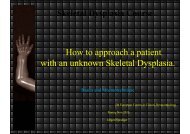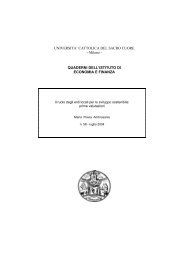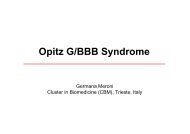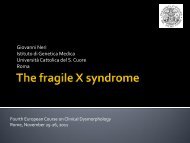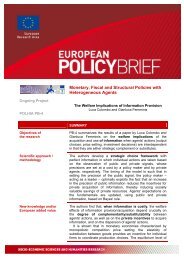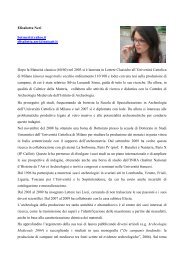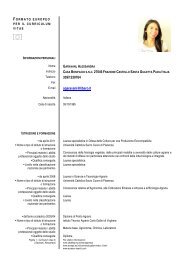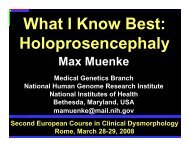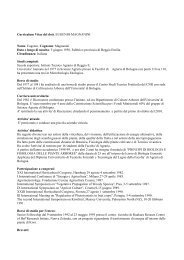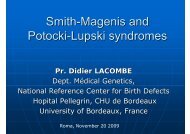Center for Medical Genetics - Istituti
Center for Medical Genetics - Istituti
Center for Medical Genetics - Istituti
Create successful ePaper yourself
Turn your PDF publications into a flip-book with our unique Google optimized e-Paper software.
Stickler syndrome<br />
Third European Course in Clinical Dysmorphology – Rome, November 20-21, 2009<br />
Geert Mortier, MD, PhD<br />
<strong>Center</strong> <strong>for</strong> <strong>Medical</strong> <strong>Genetics</strong><br />
Ghent University Hospital<br />
Ghent, Belgium
Stickler syndrome<br />
Features reported in the original paper<br />
OCULAR<br />
• congenital severe myopia (8 to 18 diopters)<br />
• spontaneous retinal detachments<br />
• chorioretinal degeneration<br />
• presenile cataracts<br />
OROFACIAL<br />
• cleft palate<br />
OSTEOARTICULAR<br />
• bony enlargement of joints at birth<br />
• joint pain in childhood (after exercise)<br />
• degenerative joint disease at an early age<br />
• mild joint hypermobility
OCULAR<br />
OROFACIAL<br />
Stickler syndrome<br />
Features reported in the subsequent literature<br />
• congenital severe myopia (8 to 18 diopters)<br />
• spontaneous retinal detachments<br />
• chorioretinal degeneration<br />
• presenile cataracts<br />
• vitreous degeneration<br />
• open angle glaucoma<br />
• cleft palate<br />
• Pierre Robin sequence<br />
• bifid uvula, submucous cleft<br />
• flat face, low nasal bridge, small chin<br />
OSTEOARTICULAR<br />
• bony enlargement of joints at birth<br />
• joint pain in childhood (after exercise)<br />
• degenerative joint disease at an early age<br />
• mild joint hypermobility<br />
• vertebral anomalies (scoliosis, wedging, endplate de<strong>for</strong>mities)<br />
AUDITORY<br />
• conductive hearing loss<br />
• sensorineural hearing loss<br />
• mixed hearing loss
Stickler syndrome<br />
Locus heterogeneity defines several types<br />
A) Autosomal dominant inheritance<br />
• type 1 Stickler syndrome: COL2A1<br />
• type 2 Stickler syndrome: COL11A1<br />
• type 3 Stickler syndrome: COL11A2<br />
B) Autosomal recessive inheritance<br />
• type 4 (?) Stickler syndrome: COL9A1<br />
Other loci??
Interaction between the collagens type II, IX, XI<br />
From Eyre DR, Weis MA, Wu JJ. Methods 2008; 45: 65-74
Type II collagen fibers are present in the cartilage and vitreous humor<br />
Cartilage matrix Vitreous humor<br />
Cartilage Eye<br />
Type II Type XI Type II Type XI<br />
Collagen Collagen Collagen Collagen<br />
COL2A1 COL11A1 COL2A1 COL11A1<br />
COL11A2 COL5A2<br />
COL2A1 COL2A1
procollagen chain<br />
collagen fiber<br />
Structure fibrillaire of fibrillar collagenen collagens<br />
3 procollagen chains <strong>for</strong>m<br />
a triple helical trimer
The <strong>for</strong>mation of the triple helix starts at the C-terminus and proceeds towards the N-terminus<br />
N C
Stickler syndrome type 1<br />
• most frequent type of Stickler syndrome (1 in 5000 to 10.000 ?)<br />
• includes the original family reported by Stickler*<br />
• autosomal dominant inheritance<br />
• mainly loss-of-function mutations in COL2A1<br />
• intra- and interfamilial variability<br />
• key features:<br />
- early-onset myopia<br />
- spontaneous retinal detachments<br />
- congenital type 1 (membranous) vitreous anomaly<br />
- cleft palate and Pierre-Robin sequence<br />
- midface hypoplasia<br />
- joint pain in childhood<br />
- early-onset osteoarthrosis<br />
- conductive or sensorineural hearing loss (mild; high tones)<br />
*Williams CJ et al. Am J Med Genet 1996;63:461
- Achondrogenesis type 2<br />
- Hypochondrogenesis<br />
- Platyspondylic dysplasia, Torrance type<br />
The family of type 2 collagen disorders<br />
Disproportionate short stature<br />
- Spondyloepiphyseal dysplasia congenita<br />
- Kniest dysplasia<br />
- SEMD Strüdwick type<br />
- Spondyloperipheral dysostosis<br />
Normal stature<br />
Lethal conditions Short trunk dwarfism Early-onset osteoarthrosis<br />
- Stickler syndrome<br />
- Czech dysplasia metatarsal type<br />
- Avascular necrosis of the femoral head<br />
- Vitreoretinopathy with phalangeal epiphyseal<br />
dysplasia
Stickler syndrome type 1<br />
Patient pictures
Study of genotype and phenotype in a large series<br />
of patients with Stickler syndrome type 1<br />
Referral of DNA samples from 278 individuals (1997-2007)<br />
188 probands were included<br />
and had ≥ 2 of the following features:<br />
• myopia<br />
• spontaneous retinal detachment<br />
• cleft palate<br />
• sensorineural hearing loss<br />
• arthropathy<br />
100 probands with a COL2A1 mutation<br />
90 probands excluded<br />
from the study<br />
• insufficient clinical data<br />
• other diagnosis<br />
Hoornaert et al. Submitted to Eur J Hum Genet
Mutation analysis of COL2A1 in a large series of Stickler syndrome patients<br />
100 probands with a COL2A1 mutation<br />
panel of 77 different COL2A1 mutations include:<br />
• 1 deletion of the entire gene<br />
• 13 nonsense mutations<br />
• 21 deletions<br />
• 1 insertion<br />
• 9 duplications<br />
• 2 insertion/deletions<br />
• 22 splice site alterations<br />
• 1 synonymous mutation (creation of a cryptic splice site)<br />
• 2 missense mutations (R565C;R904C)<br />
• 5 missense mutations (G216D;G219R;G222V;G492D;G1131A)<br />
• no hot spots in the COL2A1 gene<br />
• 13 mutations observed in more than one proband<br />
• 70/77 mutations are predicted to result in a loss of function
Frequency of features in patients with a COL2A1 mutation (n=100) and without a mutation (n=88)<br />
p-value < 0.005<br />
p-value < 0.005
Seven most discriminating features (with β-coefficients)<br />
as revealed by binary logistic regression analysis
# patients<br />
Overlap in total score between mutation positive and mutation negative group<br />
score
Box plot presentation of the total scores in both patient groups<br />
9<br />
outlier<br />
max<br />
Q3<br />
median<br />
Q1<br />
min
The presence of vitreoretinal anomalies and cleft palate are good indicators <strong>for</strong> Stickler syndrome type 1<br />
Characteristics Score<br />
-retinal abnormalities 5<br />
-positive family history 5<br />
-vitreous abnormalities 4<br />
-cleft palate 4<br />
-retinal tear and/or detachment 3<br />
-low nasal bridge 1<br />
-micrognathia 1<br />
Total score 23
Stickler syndrome type 2<br />
• autosomal dominant inheritance<br />
• mutations in COL11A1 (usually splice site mutations, intron 50 is hot spot)<br />
• key features:<br />
- early-onset myopia<br />
- spontaneous retinal detachments<br />
- type 2 (beaded) vitreous anomaly (but type 1 anomaly also observed!)<br />
- cleft palate, Pierre Robin sequence<br />
- flat face, protruding eyes, hypertelorism, low nasal bridge<br />
- mild to severe early-onset sensorineural hearing loss<br />
- radiographic abnormalities more pronounced than in type 1 Stickler<br />
• allelic with Marshall syndrome<br />
features in the original kindred*:<br />
- myopia, retinal detachment, fluid vitreous<br />
- hearing loss<br />
- ectodermal dysplasia (missing teeth, hypohidrosis)<br />
- short stature<br />
- distinctive face: hypertelorism, short nose, bulging eyes<br />
- thickening cranial vault; absence frontal sinuses<br />
* Marshall D. Am J Ophthalmol 1958;45:143
Stickler syndrome type 2<br />
Majava M et al. Am J Med Genet 2007;143A:258
Patient pictures
COL2A1 COL11A1
Stickler syndrome type 3<br />
• rare type of Stickler syndrome (only a few cases reported)<br />
• autosomal dominant inheritance<br />
• mutations in COL11A2 (in frame deletions)<br />
• key clinical features:<br />
- absence of ocular anomalies<br />
- cleft palate<br />
- sensorineural hearing loss<br />
- midface hypoplasia and upturned nose<br />
- arthropathy<br />
• allelic with Weissenbacher-Zweymüller syndrome*<br />
- Pierre Robin anomaly<br />
- snub nose<br />
- normal stature<br />
- sensorineural hearing loss<br />
- normal eyes<br />
- dumbbell-shaped femora; coronal vertebral clefts (neonate)<br />
- enlarged epiphyses (most pronounced at 13 yrs)<br />
* Pihlajamaa T et al. Am J Med Genet 1998;80:115
Stickler syndrome type 4<br />
• rare <strong>for</strong>m of Stickler syndrome (only one family reported*)<br />
• autosomal recessive inheritance<br />
• homozygous R295X mutation in COL9A1<br />
• key clinical features:<br />
- proportionate short stature<br />
- genua valga<br />
- joint pain<br />
- flat face<br />
- normal palate<br />
- moderate-to-severe sensorineural hearing loss<br />
- moderate-to-high myopia<br />
- vitreous changes (~ aged vitreous)<br />
- retinal anomalies (atrophic holes, pigmentary degeneration)<br />
- mild radiographic changes<br />
*Van Camp G et al. Am J Hum Genet 2006;79:449
Stickler syndrome type 4<br />
• flattened and irregular femoral epiphyses<br />
• flattenend metacarpal epiphyses<br />
unaffected<br />
patients<br />
Moderate-to-severe SNHL<br />
with mildly down-sloping audiogram<br />
Van Camp G et al. Am J Hum Genet 2006;79:449
patients<br />
unaffected sibs<br />
Stickler syndrome type 4<br />
Van Camp G et al. Am J Hum Genet 2006;79:449
Stickler syndrome<br />
Differential diagnosis<br />
• Type 2 collagen disorders with short stature (Kniest, SEDC)<br />
- radiographs more affected; height is low normal in Stickler<br />
• Czech dysplasia metatarsal type<br />
- short toes; no ocular and palatal involvement; R275C mutation in COL2A1<br />
• Marshall syndrome (?)<br />
- ectodermal dysplasia; skull xrays; facial dysmorphism<br />
• OSMED<br />
- recessive condition; big epiphyses, platyspondyly; typical nose; short stature<br />
• multiple epiphyseal dysplasia<br />
- degenerative joint disease without ocular and orofacial anomalies<br />
• Wagner syndrome (Stickler syndrome with only ocular involvement does exist!)<br />
- different vitreoretinal phenotype; poor dark adaptation (night blindness)<br />
- mutations in CSPG2 (versican)<br />
• conditions with cleft palate
Stickler syndrome<br />
Management<br />
• repair of cleft palate; monitoring of feeding and respiratory problems<br />
• annual evaluation by an ophthalmologist (starting in infancy)<br />
• early detection of retinal tears, holes, detachment (cryotherapy and laser therapy)<br />
• annual audiologic evaluations<br />
• avoidance of obesity and competition/contact sports<br />
(to protect the joints and prevention of retinal detachments)<br />
• joint replacement surgery



